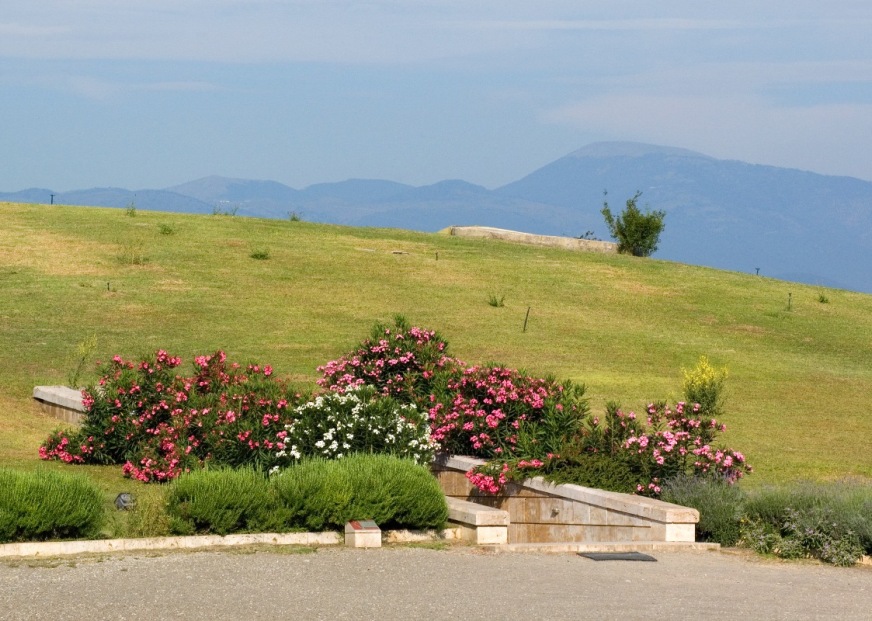4 MIN
TRAVEL TIPS
Vergina

 ... to the dynasty of king Phillip the 2nd
In 274 B.C. the king of Epirus, Pyrrhus, occupied western Macedonia and Aegae. His Gaul mercenaries robbed and destroyed the tombs in Aegae's necropolis. When, finally, Antigonos Gonatas reoccupied the city, he stared at the destroyed burial remnants and he deciced to built a great tumulus that would cover the most important part of the graves and would deter further robberies. He managed to camouflage the whole gravesite of Aegae, including the royal burial monuments so well, that the old capital was forgotten through the centuries. No one could imagine that under the huge mounds laid the royal family of Alexander the Great.
Vergina: a bounteous ancient burial site
However, History seems to remember Aegae in 1861 when Leon Heuzey, a French sightseer of central Greece discovers the old Macedonian capital. Since then and until 1974, the archaeological endeavors unearthed the palace, the theatre and a large section of the necropolis. Under the biggest mound, the Great Tumulus, the archaeological team of Manolis Andronikos discovered the tomb of Philip the 2nd and two more impressive royal graves. The tomb of Philip the 2nd was the only undisturbed. It is considered as the most impressive burial monument in the Greek peninsula and its unique burial goods continue to amaze. The grave consisted of two chambers; the main chamber and a side one. In both chambers stood a marble sarcophagus that covered a golden larnax. The larnax of the main chamber belonged to Philip the 2nd. Inside, the archaeologists found the bones of the famous king carefully placed and a circlet made of golden oak leaves and nuts. The floor of the main chamber was scattered with silver and bronze burial goods and there stood Philip's magnificent armory, almost intact. In the side chamber, the larnax unveiled the bones of a woman, proabably Philip's last wife, Cleopatra, wrapped in a golden-red cloth that the archaeologists managed to restore. The larnax, also, contained her diadem; a masterpiece of jewellery. On the floor of the side chamber were, also, found several valuable objects that would accompany the deceased in her new life, as well as, a circlet made of golden myrtle leaves and flowers.
... to the dynasty of king Phillip the 2nd
In 274 B.C. the king of Epirus, Pyrrhus, occupied western Macedonia and Aegae. His Gaul mercenaries robbed and destroyed the tombs in Aegae's necropolis. When, finally, Antigonos Gonatas reoccupied the city, he stared at the destroyed burial remnants and he deciced to built a great tumulus that would cover the most important part of the graves and would deter further robberies. He managed to camouflage the whole gravesite of Aegae, including the royal burial monuments so well, that the old capital was forgotten through the centuries. No one could imagine that under the huge mounds laid the royal family of Alexander the Great.
Vergina: a bounteous ancient burial site
However, History seems to remember Aegae in 1861 when Leon Heuzey, a French sightseer of central Greece discovers the old Macedonian capital. Since then and until 1974, the archaeological endeavors unearthed the palace, the theatre and a large section of the necropolis. Under the biggest mound, the Great Tumulus, the archaeological team of Manolis Andronikos discovered the tomb of Philip the 2nd and two more impressive royal graves. The tomb of Philip the 2nd was the only undisturbed. It is considered as the most impressive burial monument in the Greek peninsula and its unique burial goods continue to amaze. The grave consisted of two chambers; the main chamber and a side one. In both chambers stood a marble sarcophagus that covered a golden larnax. The larnax of the main chamber belonged to Philip the 2nd. Inside, the archaeologists found the bones of the famous king carefully placed and a circlet made of golden oak leaves and nuts. The floor of the main chamber was scattered with silver and bronze burial goods and there stood Philip's magnificent armory, almost intact. In the side chamber, the larnax unveiled the bones of a woman, proabably Philip's last wife, Cleopatra, wrapped in a golden-red cloth that the archaeologists managed to restore. The larnax, also, contained her diadem; a masterpiece of jewellery. On the floor of the side chamber were, also, found several valuable objects that would accompany the deceased in her new life, as well as, a circlet made of golden myrtle leaves and flowers.
 These marvellous findings are some of the amazing discoveries in Aegae. The hard work of Manolis Andronikos and his experienced team uncoved the glory and the history of a city that played a crucial role in the rise of the kingdom that upset all the ancient world.
These marvellous findings are some of the amazing discoveries in Aegae. The hard work of Manolis Andronikos and his experienced team uncoved the glory and the history of a city that played a crucial role in the rise of the kingdom that upset all the ancient world.
Article by museummasters.com


